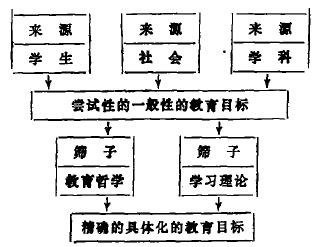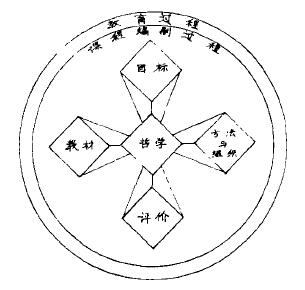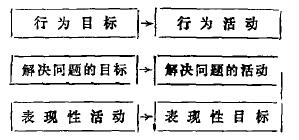泰勒的《课程与教学的基本原理》—兼述美国课程理论的兴起与发展
-
1) ① Tyler, R, W., Constr ucting Aehievement Test, 1934. “评价原理”可概括为这样7个步骠或阶段:(1)确定教育计划的目标; (2)根据行为和内容来界说每一个目标; (3)确定使用目标的情境; (4)设计呈现惰境的方式; (5)设计获取记录的方式3(6)确定评定时使用的计分单位; (7)设计获取代表性样本的手段。2) ② Tyler, R. W, Basic Princi ples of Curriculum and Inslruction, 1949. “课程原理”可简约成这样4个步票或阶段: (1)确定教育目标; (2)选择学习经验; (3)组织学习经验; (4)评价结果。3) ③ Husen, T, , et al. (Eds, ), The International Encyclopedia of Education, Vol. 3, 1985, P.1747.4) ④ Tanner, D, & Tanner, L. N., Curriculum Devele pment :Theory intO Practice, 2nd ed., 1980, P.90.5) ⑤ 黄炳煌q 《课程理论之基础》,台掏文景出版社1985年版,第2页。6) ⑥ Tyler, R.W., A Rationale for Program Evaluation.In Madaus, G.F.et al. (Ed8.), Evaluation Mo- d8ls, 1983, p.67.7) ⑦ Tyler, R.W., A Rationale for Program Evaluation.In Madaus, G.F.et al. (Ed8.), Evaluation Mo- d8ls, 1983, p.67.8) ① Schubert, W. & Schubert, A. L.L., Ralph W.Tylph; An Interview and Antecedent Reflection8, J ournG1 of Thought, Vol.21, No.1, Spring 1985.9) ② Schubert, W. & Schubert, A. L.L., Ralph W.Tylph; An Interview and Antecedent Reflection8, J ournG1 of Thought, Vol.21, No.1, Spring 1985.10) ③ Schubert, W. & Schubert, A. L.L., Ralph W.Tylph; An Interview and Antecedent Reflection8, J ournG1 of Thought, Vol.21, No.1, Spring 1985.11) ④ Tyler, R. W., Pers pectives on American Education :Reflectiors on the Past... Challenges f0r the Fu- ture, 1976.12) ⑤ K0lodziey, H. M. (Ed.), Ralph W.Tyler :A Bibliography, 1929-1986, 1986.13) ⑥ Good1ad, J.I, , Introduction, In Pers pectives 0n American Euducation, pp.9-10.14) ⑦ Strickland, K, , Preface, Journal of Thought, Vol.21, No.1, Spring 1986.15) ⑧ Neubauer, D., Highlighting the Contributions of a Leading Educator:The Ra1ph W.TyIer Project, Educati 0ncl Leadershi p, Oct。1976, P.68.16) ⑨ Wa1ker. D.F. & So1tis, J.F, Curricu1um and Aims, 1986, P. 116.17) ① Bobbitt, F., The Curriculum, 1918.张师竹译:《课程》(“代表教育名著"), 商务印书馆1928年版。博比特当时译为波比忒。18) ② Zais, R.S., Curriculums Princi ples and FouncationS, 1976, p.5.19) ③ National Education Association, Commission on the Reorganization of Secondary Education, The Cardinal Princi ples of Secondary Education, 1918。20) ④ Pinar, W.(Ed.), Curriculum Theorizing: The Reconce ptualists, 1975, p.40.21) ⑤ 参见瞿葆奎、施良方。《“形式教育”与“实质教育”》(.上),《华东师范大学学报(敏育科学版)》1988年第1期。22) ⑥ Tay1or, F.W, , The Principles of Scientific Management, 1911, P.43.23) ⑦ Callaban, R.E., Education and the Cult of Efficiency; A Study of the Social Forces That Have Shaped the Administration oj the Public Schools, 1962, p.148.24) ⑧ 麦克尼尔著、施良方等译。《课程导论》第2版), 辽宁教育出版社1990年版,第353页.25) ① 例如,博比特在1912年的《消除教育中的浪费》一文中说,科学管理的4条原则是: (1)要在所允许的全部时间里使用所有的设施,(2)通过最大限度地发挥工作人员的效率,尽可能减少人员,(3)消除浪费; (4)把科学管理的一般原则应用于教育理论本身。这意昧着:要根据不同学生的能力来进行教育, 邸要求课程内容多样化,以满足社区中每一类个体的需要,训练和学习的过程要有灵活性, 使每一个人都能正好获得自已所需要的东西。(Bobbitt, The Elimination of Waste in Education. The Elementory School Teacher, VoI, 12, No. 6,Feb. 1912.)26) ② 例如,博比特在1913年的《把管理的某些一般原理应用于城市学校系统》一文中认为:三年级数学敏师应该教会学生每分钟做对26道加法题,四年级教师要教会学生每分钟做对34道加法题。如果教师不能使学生达到这个标准数, 就说明教师没有完成任务, 其失职的程度与学生少做几道题成正比。同样,教师也没有贵任教学生超出这些标准数。(Bobbitt, Some General Principles of Management Applied to thc Problems of City- School Systems, Twelfth Yearbook of the National Societyfor the Strdy of Education, Part 1, 1913.)27) ③ 例如,博比特在1915年的《高中成本》一文中提及r他以学生每1000小时的学习时间为成本单位。在他所取的25所中学样本中,数学教学的成本为30-196美元; 拉丁语教学成本比数学成本平均高20%。(Bobbitt, High Scbool. Costs,The School Review, V01。23, N0.8, 1915.)28) ④ Bobbitt, F., The Curriculum, pP.43.29) ⑤ Bobbitt, F., The Curriculum, pP.283.30) ⑥ Bobbitt, F., The Objectiver of Secondary Education, The School Review, Vol. 28, No.10, Dec.’1920.31) ⑦ Bobbitt, F., The Curriculum, pP.43.32) ⑧ Bobbitt, F, How t0 Make 4 Curriculum, 1924.容子偏译; 《课程编制》, 商务印书馆1943年版。33) ① McNeiI, J, D, , Curriculum; A Conprehensive Introduetion, 4th ed, PP. 381-383.34) ② Charters, W.W., Curicu1um for Women, University of Illinois Bulletin, V01, 23, NO.27, Marcb 8,1926,35) ③ Charters, W. W, Curriculum Constqxction,1923, PP.30.36) ④ Charters, W. W, Curriculum Constqxction,1923, PP.82.37) ⑤ Charters, W. W, Curriculum Constqxction,1923, PP.75.38) ⑥ Charters, W. W, Curriculum Constqxction,1923, PP.84.39) ⑦ Charters, W. W, Curriculum Constqxction,1923, PP.102.40) ⑧ McNeiI, J, D, , Curriculum; A Conprehensive Introduetion, 4th ed, PP.384.41) ① Whipp1e, G, M, , What Price Curricu1um Making, School cnd Society, V0I.31, March 15, 1930.42) ② Eliot, C.W., Letters to The New York Time, Vo1.72, No.23946,Au8.7, 1923.43) ③ 该《年鉴》以《课程编制的基础和技术(The Foundations and Technique of Curriculum Making)>为书名(1927), 共分2篇,第一篇是《课程编制; 过去与现在(Curriculum-Making; Past and Present)》第二篇是《课程编制的基础(Tbe Foundations of Curricu1um- Making)》.44) ④ Curriculum- Making; Past and Present, pP.X, 51.45) ⑤ Curriculum- Making; Past and Present, pP.X, 51.46) ⑥ TyTer, R. W, Curricu1um Development in the Twenties and Thirties. In NSSE Seventieth Yearbook, 1971, Part 1-The Curriculum; Retros pect and Prospect, P.31.47) ① Tyler, R. W, Reflecting on the Eight- Year Study, Joxrna1 of Thought, Vol。21, No.1, 1986, P.16.48) ② Ibid.据Connel, W.F., A History of Education in the Twentieth Century World(1980)的统计, 在1930-1940年的10年中,14-17岁中学生在学率由28%猛增到52%(见赵祥麟主编:《外国现代教育史》华东师范大学出版社1987年版, 第280页)。49) ③ Husen, T, et al. (Eds, ), The International EncyclopediG of Education, Vo1, 3, PP.1656.50) ④ Husen, T, et al. (Eds, ), The International EncyclopediG of Education, Vo1, 3, PP.1647.51) ⑤ 泰勒多次反复强调; “这项研究的确切时间是在1934- -1942年期间".(Tyler, R. W, , New Dimensions in Cu- rriculum Development, Phi Delta Kappan, Sep。1966).而美国教育史学家克雷明(Cremin, L. A.)在《学校的变迁(The Transformation of the Sch0ol)》-一书中则认为, “八年研究”的时间是1932年至1940年(英文版,第253页)。52) ⑥ 一些基金会从1933年起先后提供了160多万美元的资助(见Cremin, The Transformotion of lhe School, P.257).53) ① Chamber1in, D. al, D{d They Succeed in College? 1942, pp. 207-208。54) ② Aikin, M., The Story of the Eight- Year Study, 1942, p, 150.55) ③ Tyler, R. W, , The Five Most Significant Curricu1um Events in the Twentieth Century, Educ6- tlonal. Leadership, Dec. 1986/Jan. 1987.56) ④ Tyler, R. W, , The Five Most Significant Curricu1um Events in the Twentieth Century, Educ6- tlonal. Leadership, Dec. 1986/Jan. 1987.57) ⑤ 赵祥麟主编:《外国现代教育史》,第283-284页。58) ① “八年研究”系列报告的总题目是《美国教育的冒险性尝试(Adveature in American Education)》, 其中包括; Giles, H. H, et al, , Explorin8 th0 Curriculum, 主题是对30所学校的实验工作进行概述; Srpith, E.R., eta1, , Ap praising and Recording Student Progress, 主要论及30所学校的评价和记录的情况,Chamber- 1in, D.etal.Did They SuccedinCollege主要是对来自30所实验学校的毕业生在大学期间进行追踪研究, 其研究结果是通过与其它中学毕业的大学生进行对照比较后得出的,Thirty Schools Tell TheirStory, 这本书由30所实验学校分别提供的报告所组成。此外, 还有许多单篇的或专题性的报告。(参见Cremin, L. A., The Transformation 0f the School, PP.253- 254.)59) ② Schubert, W. & Schubert, A.L, L, , Ralph W。Tyley in Review, JovrnQl of Thought, Vo1. 21, NO.1, 1986.60) ③ Tyler, R. W., A Rationale for Program Evaluation. In Evaluotion. Models, p.70.61) ④ 泰勒于1929年应饿亥俄州立大学教育研究所所长查特斯(Charters, WW。)之邀, 主持该所的成绩测验室的工作。由于当时相当大一部分学生在读完一年级之后就不再继续他们的大学教育了,人们敦促大学教师改进教学, 尤其是大学一二年级的教学。查特斯认为,通过有关研究的帮助和测验与测量的运用, 可以显著地改进大学里的教与学。泰勒当时与任课教师一起,集中力量研究本科生生物学学程的教学。经过2年的努力, 于1931年撰写了《编制成绩测验的一般技术(A Generalized T echnique for Constructing Achievement TestS)》一文。后收入1934年出版的成绩测验的编制(Constructing Achievement TestS)》一书。1934年,泰勒应邀主持“八年研究”的评价组工作,就把这一原理用于指导“八年研究”的评价工作。62) ⑤ Schubert, W. & Schubert, A.L, L, , Ralph W。Tyley in Review, JovrnQl of Thought, Vo1. 21, NO.1, 1986.63) ① Tyler, Basic Princi ples of Curriculum and Instruction, PP.1.64) ② Tyler, Basic Princi ples of Curriculum and Instruction, PP.3.65) ③ 参见:Popham, W.J. & Baker, E.L., Establishing Instructional Goals, 1970, PP.81-100.66) ④ Tyler, Basic Princi ples of Curriculum and Instruction, PP.5-6.67) ⑤ Tanner, D. & Tanner, L.N, Curricrlum Develo pments Theory into Practice, 2nd ed.p. 91.68) ⑥ Tyler, Basic Princi ples of Curriculum and Instruction, PP.6.69) ① Scbubert, w. & Schubert, A.L.L., Ralpb W.Tyler in Review, Journal of Thought, Vo1.21.No.1, Spring 1986.70) ② Tanner, D. & Tanner, L.N, Curriculum Developments Theory into Practice, 2nd ed., pp.86-87.71) ③ 布鲁纳著, 邵瑞珍译、王承绪校:《教育过程》, 《布鲁纳教育论著选》, 人民教育出版社1989年版, 第7页。72) ① Tyler, Basic Principtes of Curricu1um and Instruction, PP.46-47.73) ② Tyler, Basic Principtes of Curricu1um and Instruction, PP.62.74) ③ Ebel, R.L., Behavioral Objectives, A C1ose Look, Phi Delta Kappoan, ' V01, 52, No.3, Nov. 1976.75) ④ 杜威著、王承绪译:《民主主义与教育》,人民教育出版社1990年版, 第170页。76) ① Tyler, Basic Princi ples of Curriculum and Instruction, pP.64.77) ② Tyler, Basic Princi ples of Curriculum and Instruction, pP.65.78) ③ Downey, M., The Psychological Background to Curriculum Planning.In Kelly, A.V. (Ed.), Curri- Culum Context, 1980,PP.66-67.79) ④ Tyler, Basic Princi ples of Curriculum and Instruction, pP.65—68.80) ⑤ Tyler, Basic Princi ples of Curriculum and Instruction, pP.81.81) ① Ibid, p.95.82) ② Ibid, p.95.83) ③ Ibid.p.104.84) ① Ibid., P.128,85) ② Tanner, D. & Tanner, L。N., Curricu1um Develo pment: Theory into Practice, 2nd ed., p. 91.86) ③ Husen, T. et al, (Eds.), The International Encyc1o pedia of the Educati on, Vol.2, 1985, P.1142.87) ④ Goodlad, J.I., Curriculum :State of the Field, Review of Educational Research, V01.39;No. 3, 1969.88) ⑤ Tanner, D. & Tanner, L。N., Curricu1um Develo pment: Theory into Practice, 2nd ed., p. 8489) ⑥ Ty1er, R.W., New Dimensions in Curriculum Development, Phi Delta K aPPan, Sep.1966.90) ⑦ Ty1er, R.W., New Dimensions in Curriculum Development, Phi Delta K aPPan, Sep.1966.91) ① Ibid,92) ② Tyler, R. W., W here Learning Happens, The Edncati on Digest, May 1975.93) ③ Tyler, R. W., Reconstructing the Total Educational Enviroiment, Phi Delta Kappan, Vol, 51, No.1, Sep.1975。94) ④ Tyler, R. W., Reconstructing the Total Educational Enviroiment, Phi Delta Kappan, Vol, 51, No.1, Sep.1975。95) ① Tyler, R. W., Two New Emphases in Curricu1um Development, Educationah L8adershi p Oct.1976。96) ② Tyler, R.W., New Dimensions in Curriculum Development, Phi DeltG Kap pan, Sep.1966.97) ④ Tyler, R.W., New Dimensions in Curriculum Development, Phi DeltG Kap pan, Sep.1966.98) ⑤ Tyler, R.W., New Dimensions in Curriculum Development, Phi DeltG Kap pan, Sep.1966.99) ③ Tyler, Basic Princi ples of Curriculum and Instruction, D.43.100) ⑥ Tyler, R. W., Specific Approaches to Curriculum Development. Io Schaffarzick, J. & Hampson, D.H, (Eds.), Strategies f0r Curricxlum Development, 1975. P.26.101) ⑦ Schwab, J.J., The Practica1 :Arts of Eclectic, School Review, Aug, 1971; and Schwab, J.J., The Prac~ tical:A Language for Curricuhum, 1971.102) ⑧ Tyler, R.W., Specific Approaches to Curriculum Developinent.In Strategies for Curricu]:m Deve- 1o pment, P.26.103) ⑨ Mitze1, H.E. (Ed.), Encyclopedia of Educationcl Research, 5th ed, D.423.104) ⑩ Beane, J. A. et al, Curricu1um Planning and Develo pment, 1986. p.65.105) ① Tanner, D, & Tanner, L. N., Curricu1um DeveIopment :Theory into Practice, 2nd ed. PP.84.106) ⑥ Tanner, D, & Tanner, L. N., Curricu1um DeveIopment :Theory into Practice, 2nd ed. PP.83.107) ⑨ Tanner, D, & Tanner, L. N., Curricu1um DeveIopment :Theory into Practice, 2nd ed. PP.70.108) ② 杜威: 《教育科学的资源》,见赵祥麟、王承德编译:《杜威救育论著选》,第284页。109) ③ 泰勒在主持“八年研究"的评价工作时,箜常与波特-一起工作。Journa1 of Thought, Vol.21, N0.1, 1986.110) ④ Bode, B. H., Education at the Crossroads, Progressive Educatio%, Vo1.8, Nov.1931.111) ⑤ Taba, H., General Techniques of Curriculum Planning.NSSE Forty-fourth Yearbook, Part I, dme- rican Education in Postwar Peri od, Curricubum Reconstruction, 1945。112) ⑦ Kliebard, H.M., Reappraisal, The Ty1er Rationale In Curricxlsm Theorizing, P.71.113) ⑧ Good1ad, J.I., Cwrriculum Inquiry :The Study of Curricu8um Praqtice, 1979, P.19.114) ① Tyler, R. W, A Rationale for Progtam EvaIuatiun.In Eva1uatio忧Models。Giles, et al, Explorin2 the CurpiculU9H, DP. 22-48、Schubert, J, J, Ra1ph W. Tyler in Review, Jou7wal of 1honght, VoI. 21, No.1, 1986.115) ③ Husen, The International Encyc1opedia of Edication, V01.2, p.1142.116) ④ Husen, The International Encyc1opedia of Edication, V01.2, p.1142.117) ⑤ Taba, H., Curricu1um Development, 1962, pp.347-379。118) ⑥ 最典型的是,他在论述课程编制的4个基本问题时, 也把目的(purposes)与目标(objectives)很用的。见Basic Princi phes of Curricu1um and Instruction; Two New Emphases in Curricu1um Development; A Ra- tionale for Program Eval uation.119) ① Wheeler, D.K., Curricu1um Process, 1967, P.31.转引自欧用生编著:《课程发展的基本原理》,台湾复文园书出版社1985年版,第23页。120) ② Tanner, D. & Tanner, L. N., Curriculum Develo pment :Theary into Practice, 2nd ed., PP.88, 85.121) ③ Tanner, D. & Tanner, L. N., Curriculum Develo pment :Theary into Practice, 2nd ed., PP.88, 85.122) ④ Beane, J. A.et al., Curricuhum Plamming and Development, P. 66.123) ⑤ Walker D.E. & Soltis, J. F., Curriculum and Aims, P.50.124) ① K 1iebard, H., Persistent Curriculum Issues in Historical Perspective, In Curriculum The orizing P.45.125) ② Tanner, D. & Tanner, L. N, , Curricu1um Deve1opment:Theory into Practice, 2nd ed., p. 91.126) ③ Kel1y, A.V., Ideologica1 Constraints on CurricuIum PIanning, In Kelly, A.V. (Ed, ), Curriculum Contc xt, 1980, PP.14-15.127) ④ 布卢姆等编,罗黎辉等译、施良方校r《教育目标分类学, 第一分册; 认知领域》, 华东师范大学出版社1986年版, 第6页。128) ⑤ 克拉斯沃尔(Krathwohl, D.R.)、布卢姆等编,施良方等译、瞿葆奎校; 《教育目标分类学, 第二分册:憎感领城》, 华东师范大学出版社1989年版, 第3、7页。129) ⑥ 克拉斯沃尔(Krathwohl, D.R.)、布卢姆等编,施良方等译、瞿葆奎校; 《教育目标分类学, 第二分册:憎感领城》, 华东师范大学出版社1989年版, 第3、7页。130) ① 布卢姆等编; 《教育目标分类学,第一分册:认知领域》, 第19页。131) ② Ebe1, R.L, , Behavi0ral Objectives : A Close L00k, Phi Delta K appan, Vo1, 52, No. 3, Nov.1970.132) ③ Eisner, E.W., The Educational Imagination: On the Design and Eva1uation of" Sc hooE' ProgramS, 1979.PP 100-101.133) ④ Eisner, E.W., The Educational Imagination: On the Design and Eva1uation of" Sc hooE' ProgramS, 1979.PP 103.134) ⑤ Eisner, E.W., The Educational Imagination: On the Design and Eva1uation of" Sc hooE' ProgramS, 1979.PP 104.135) ① CIPP是英文Context, Input, Process, Product的缩写, 即背景、输入、过程和成果的评价。136) ② Stufflebeam, D.L., The CIPP Model for Program Evaluation. In Eva1uation Mode1s.137) ③ Cronbach, L, J, Evaluation for Course Improvemeat, In Heath, R. W. (Ed.), New Curricu1a, 1964, PP.233—234.
-






 下载:
下载:




